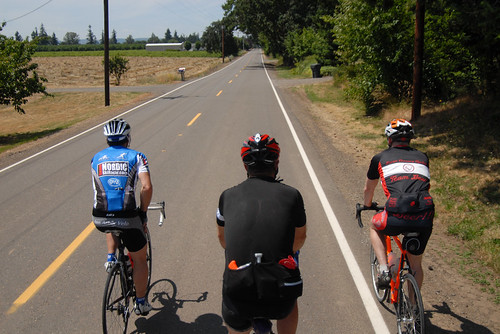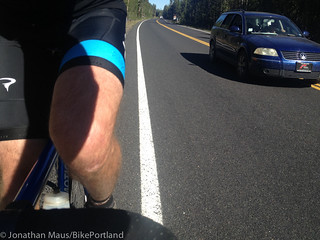This is part two of our three-part series on Oregon’s passing laws written by our legal correspondent Ray Thomas. Read part one here.
When is it OK to ride side-by-side?
While the law is not entirely clear, it makes no sense to prohibit a driver from merely moving slightly over the double yellow line when the driver can lawfully perform the same maneuver to go around a pothole or a dog in the road.
ORS 814.430 (the Bill of Rights statute) provides that riders who are traveling “at less than the normal speed of traffic using the roadway at that time and place under the existing conditions” must ride “as close as practicable to the right curb or edge of the roadway” except:
(e) When operating a bicycle alongside not more than one other bicycle as long as the bicycles are both being operated within a single lane and in a manner that does not impede the normal and reasonable movement of traffic.
The statute seems to indicate that riders may ride as many abreast as they want so long as no other traffic is impeded. However, once overtaking traffic is slowed, riders must travel no more than two abreast, so long as “the normal and reasonable movement of traffic” is not impeded.
Does this mean that riders on a roadway may ride two abreast even when going slower than overtaking traffic? It seems reasonable that the riders may maintain their side by side position or double paceline so long as overtaking motor vehicle operators are able to safely go around the group.
So, if there is no oncoming traffic, it is a passing zone, and overtaking traffic can easily go around the riders the law seems pretty clear. But what if it occurs in a no passing zone?
Currently some drivers and law enforcement officers argue that a motor vehicle operator may not “pass” persons on bicycles in a “no passing zone”. This mechanistic approach encourages a frustrating gridlock condition in the traffic lanes. The better practice is to interpret the traffic statutes in a way that encourages a fluid and dynamic flow of traffic and allows the natural cooperative attitude of drivers and riders to team up to share the road. Oregon statute supports such a view.
ORS 811.420 states:
-
(1) A person commits the offense of passing in a no passing zone if the person drives a vehicle on the left side of a roadway in a no passing zone that has been established and designated to prohibit such movements by appropriate signs or markings posted on the roadway.
(2) The authority to establish and post no passing zones for purposes of this section is established under ORS 810.120 (Designation of no passing zones).
(3) The provisions of this section do not apply under any of the following circumstances:
-
(a) When a driver turns left into or from an alley, intersection, private road or driveway.
(b) When an obstruction or condition exists making it necessary to drive to the left of the center of the roadway provided that a driver doing so shall yield the right of way to all vehicles traveling in the proper direction upon the unobstructed portion of the roadway within a distance that would constitute an immediate hazard.
The passing zone statute prohibits a person from passing by driving a vehicle “on the left side of a roadway in a no passing zone”. What does it mean to “drive a vehicle on the left side of the roadway in a no passing zone”? Is the statute violated by the driver who merely allows the driver’s side tires to go slightly over the double yellow line to pass a single rider or line of persons on bicycles riding side-by-side? While the law is not entirely clear, it makes no sense to prohibit a driver from merely moving slightly over the double yellow line when the driver can lawfully perform the same maneuver to go around a pothole or a dog in the road. Common sense and the statute support a maneuver allowing motorized and human powered vehicle operators to move around each other and then proceed at their different rates of speed:
The legal bottom line is that presence of people on bicycles in the lane ahead is a “condition” that “exists making it necessary to drive to the left of the center of the roadway.” Thus, while a driver is prohibited from driving “on the left side of the roadway in a no passing zone” by ORS 811.420(1), the exceptions in ORS 811.420(3)(b) allow the driver to “drive to the left of the center of the roadway” for a “condition” that makes it “necessary”. Driving on the “left side of the roadway” suggests a greater intrusion over the center line than to merely move over to “drive to the left of the center of the roadway”. And the narrow width of track of a bicycle allows the driver to safely pass without taking the passing vehicle all the way “on the left side of the roadway”.
Doug Parrow, a Salem-area bicycle advocate and blogger, has researched the legislative history regarding ORS 811.420 and found that Senator Floyd Prozanski very clearly represented the view during the Safe Passing Bill’s hearings that ORS 811.420 allows a motor vehicle operator to cross a double yellow line in order to pass someone on a bicycle, and equated a bicycle to a farm tractor or any other slow moving vehicle.
Of course this interpretation of the language achieves the riders’ desire to maintain speed and safe position on the roadway when being overtaken by drivers. It is frustrating and dangerous for overtaking drivers to follow impatiently or honk the horn when the roadway ahead is clear and it is safe to go around the riders. Drivers need to know that their driver’s side tires will not be vaporized by passing over the double yellow line in order to give safe berth to persons on bicycles. Many unnecessary roadside conflicts would never occur if drivers would willingly move over to pass persons on bicycles safely.

(Photo © J. Maus/BikePortland)
This article is part of our monthly legal series with Portland-based lawyer and bike law expert Ray Thomas of Swanson, Thomas, Coon & Newton. (Disclaimer: STC&N is a BikePortland advertiser and this monthly article is part of our promotional partnership.)



